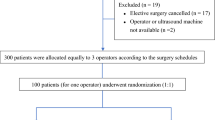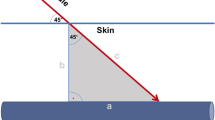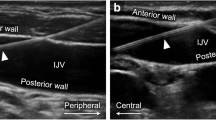Abstract
We report a method for preventing misplacement of percutaneous silastic catheters in superficial vein tributary or venous plexus. Catheters inserted less than the length calculated by surface anatomy measurement due to resistance were studied in three patients. Contrast X-rays (Omnipaque, Nycomed Imaging AS, Oslo, Norway) of the catheters was performed to confirm the catheter tip placement position. On initial assessment, the catheter tip placement was thought to be satisfactory and infusion of TPN commenced. Following signs of extravasation, re-examination of the contrast X-rays demonstrated that multiple thin rays of omnipaque could be traced in different directions like a cobweb. In the third infant, we recognised the “cobweb” sign and prospectively withdrew the catheter tip 2 cm. Repeat contrast X-ray confirmed that the catheter tip was in a major superficial vein, infusion continued without further complication. We conclude that when the “cobweb” sign is noticed then the catheter should be removed or withdrawn 2 to 3 cm and repeat contrast X-ray performed.
This is a preview of subscription content, access via your institution
Access options
Subscribe to this journal
Receive 12 print issues and online access
$259.00 per year
only $21.58 per issue
Buy this article
- Purchase on Springer Link
- Instant access to full article PDF
Prices may be subject to local taxes which are calculated during checkout



Similar content being viewed by others
References
Dudric SJ, Wilmore DW, Vars HM, Rhoads JE . Long term total parental nutrition with growth, development and positive nitrogen balance. Surgery 1968;64:132–142.
Ali MN, Jing L, Robert SG, Margret SM, Ian RH . Death as a complication of peripherally inserted central catheters in neonates. J Pediatr 2001;138:599–601.
Spriggs DW, Brantley RE . Thoracic and abdominal extravasation as complication of hyperalimentation in infants. Am J Roentgenol 1977;128:419–422.
Seguin JH . Right sided hydrothorax and central venous catheters in extremely low birth weight infants. Am J Perinatal 1992;9:154–159.
Giacolia GP . Cardiac tamponade and hydrothorax as complication of central venous parenteral nutrition in infants. J Perent Ent Nutr 1991;15:110–113.
Reece A, Ubhi T, Craig AR, Newell SJ . Positioning long lines: contrast versus plain radiography. Arch Dis Child Fetal Neonatal Ed 2001;84:F129–F130.
Cartwright DW . Central venous lines in neonates: a study of 2186 catheters. Arch Dis Child Fetal Neonatal Ed 2004;89:F504–F508.
Gablla G . Venous system. In: Williams PL, Bannister LH, Berry MM, Collins P, Dyson M, Dussek JE, Ferguson MW, editors. Grays Anatomy; The Anatomical Basis of Medicine and Surgery.38th Ed. Edinburgh: Churchill Livingstone; 1995 p. 1574–1604.
Author information
Authors and Affiliations
Additional information
Financial Support: None.
Rights and permissions
About this article
Cite this article
Aladangady, N., Roy, R. & Costeloe, K. The Cobweb Sign: Percutaneous Silastic Long Line Tip Placement in Tributaries of Superficial Veins. J Perinatol 25, 671–673 (2005). https://doi.org/10.1038/sj.jp.7211355
Published:
Issue Date:
DOI: https://doi.org/10.1038/sj.jp.7211355
This article is cited by
-
Spontaneous correction of misplaced peripherally inserted central catheters
The International Journal of Cardiovascular Imaging (2018)



